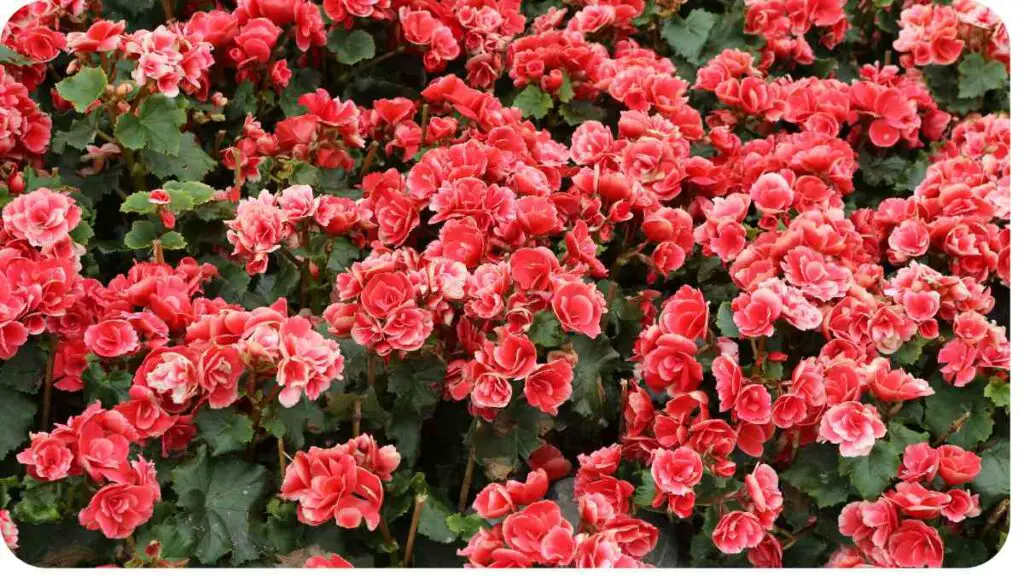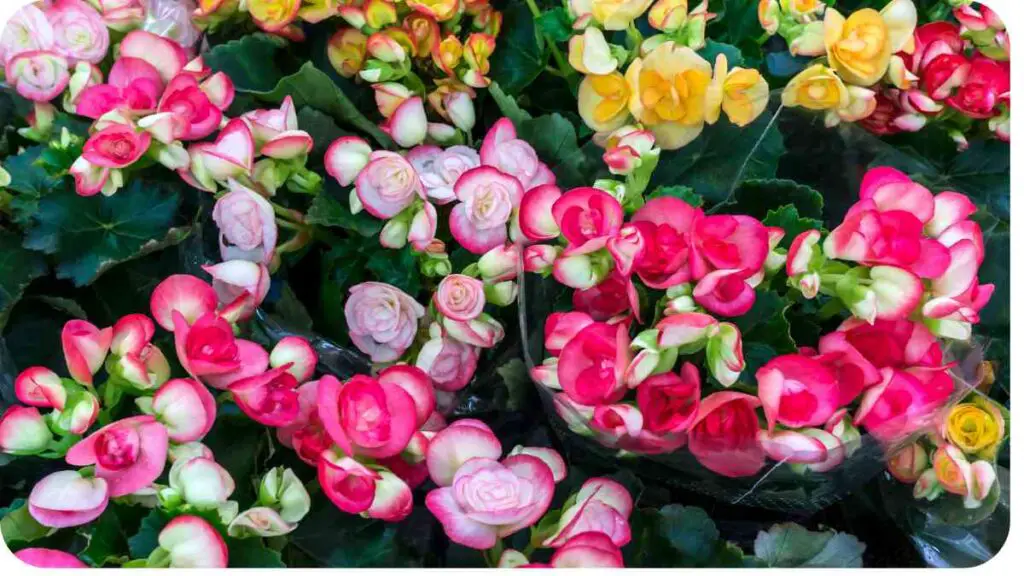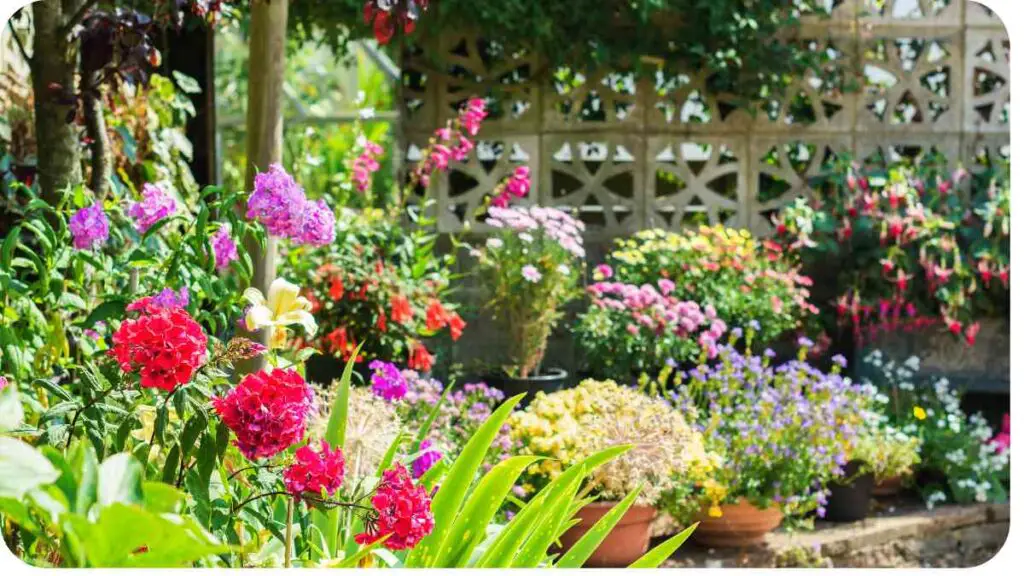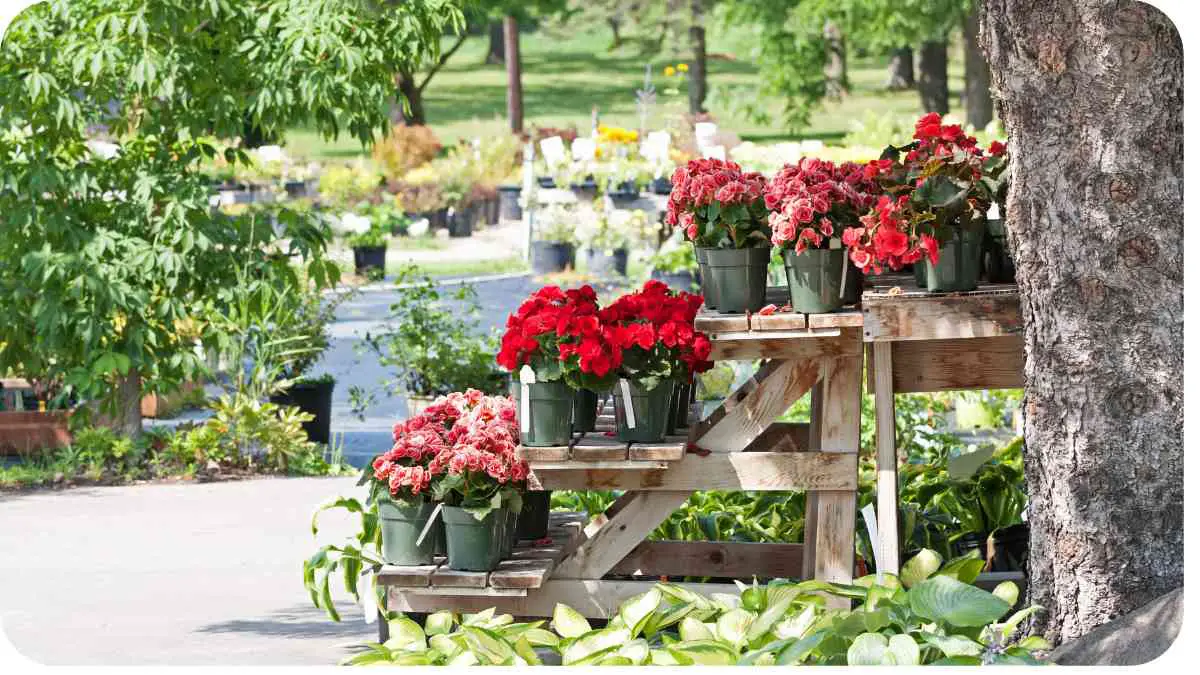Begonias are like a burst of joy in any garden, with their vibrant colors and diverse textures. Whether you’re a seasoned gardener or just starting out, adding begonias to your collection can elevate your green space to new heights.
In this comprehensive guide, we’ll delve into the mesmerizing world of begonias, exploring everything from popular varieties to care tips and beyond.
| Key Takeaways |
|---|
| 1. Begonias offer a wide range of colors, textures, and varieties, making them versatile plants for any garden. |
| 2. Proper growing conditions, including well-drained soil, partial shade, and regular watering, are essential for healthy begonias. |
| 3. Regular maintenance tasks such as deadheading, pruning, and fertilizing can help keep begonias thriving throughout the growing season. |
| 4. Begonias can be propagated through various methods, including stem cuttings, leaf cuttings, and division, allowing you to expand your collection. |
| 5. Sustainable practices, such as organic pest control, water conservation, and native planting, promote eco-friendly begonia cultivation. |
2. The Fascinating World of Begonias

Begonias belong to the Begoniaceae family, which comprises over 1,800 species, offering an astonishing array of colors, shapes, and sizes. From delicate trailing varieties to bold, bushy specimens, there’s a begonia for every taste and preference.
Enhance your front yard with the timeless elegance of roses. Discover landscaping advice for incorporating these beloved blooms into your outdoor space, creating a picturesque landscape that captivates with every petal.
| Begonia Type | Description |
|---|---|
| Tuberous | Known for their showy, vibrant flowers |
| Rex | Characterized by colorful, textured leaves |
| Rhizomatous | Grown for their unique foliage patterns |
| Cane | Tall, upright stems with clusters of flowers |
These are just a few examples of the diverse range of begonias available to enthusiasts.
3. Popular Begonia Varieties
When it comes to begonias, the options are virtually endless. Here are some of the most popular varieties that you might consider adding to your garden:
| Variety | Description |
|---|---|
| Begonia ‘Dragon Wing’ | A vigorous, heat-tolerant variety with glossy, wing-shaped leaves and bright red or pink flowers |
| Begonia ‘Nonstop’ | Compact plants with large, double flowers in a range of colors, including red, pink, and orange |
| Begonia ‘Angel Wing’ | Named for its angelic, wing-shaped leaves, often adorned with silver speckles |
| Begonia ‘Rex’ | Known for its striking foliage, featuring intricate patterns and vibrant colors |
Each of these varieties brings its own unique charm to the garden, adding pops of color and texture wherever they’re planted.
4. Growing Conditions for Begonias
Begonias thrive in well-drained, fertile soil and prefer partial shade, making them ideal for planting under trees or in areas with dappled sunlight. However, some varieties, like the ‘Dragon Wing,’ can tolerate more sun, while others, such as the ‘Rex’ begonias, prefer shadier conditions.
It’s essential to provide adequate moisture for begonias, as they don’t tolerate drought well. Water them regularly, but be careful not to overwater, as this can lead to root rot.
Transform your yard into a thriving ecosystem with the help of ants. Explore landscaping advice on how these tiny creatures contribute to soil health and plant growth, fostering a balanced environment for your outdoor oasis to flourish.
5. Care and Maintenance Tips
Taking care of begonias doesn’t have to be complicated. Here are some essential tips to keep your begonias healthy and thriving:
- Deadheading: Remove spent flowers regularly to encourage continuous blooming.
- Fertilization: Feed your begonias with a balanced fertilizer during the growing season to promote vigorous growth and abundant blooms.
- Pruning: Trim back leggy stems to encourage bushier growth and remove any damaged or diseased foliage promptly.
- Mulching: Apply a layer of organic mulch around the base of your begonias to conserve moisture, suppress weeds, and regulate soil temperature.
By following these simple guidelines, you can enjoy beautiful begonias year after year.
6. Dealing with Common Begonia Pests and Diseases

While begonias are relatively pest and disease-resistant, they can still fall victim to certain issues. Some common pests and diseases to watch out for include:
Elevate your yard’s allure with the majestic presence of ash trees. Uncover expert insights on the benefits and considerations of incorporating these stately trees into your landscape design, adding shade, structure, and natural beauty to your outdoor haven.
| Pest/Disease | Symptoms | Treatment |
|---|---|---|
| Powdery Mildew | White powdery patches on leaves | Remove affected foliage and improve air circulation |
| Spider Mites | Fine webbing and stippling on leaves | Spray with insecticidal soap or neem oil |
| Botrytis Blight | Grayish mold on leaves and flowers | Remove infected plant parts and improve air circulation |
Regular inspection and prompt action are key to preventing these problems from spreading.
Shall I continue with more sections of the article?
7. Propagation Techniques
One of the joys of growing begonias is the opportunity to propagate them and share their beauty with friends and family. Here are some common propagation methods for begonias:
Stem Cuttings
- Select a healthy stem with several leaves.
- Cut the stem just below a leaf node.
- Remove the lower leaves and dip the cut end in rooting hormone.
- Plant the cutting in a well-draining potting mix and keep it moist until roots develop.
Leaf Cuttings
- Choose a healthy leaf and cut it into sections, making sure each section has a vein.
- Lay the sections on top of a moist, well-draining potting mix.
- Cover them lightly with plastic to maintain humidity and wait for roots to form.
Division
For rhizomatous begonias, division is an effective propagation method.
- Carefully dig up the rhizomes and separate them into smaller sections, each with at least one growth point.
- Plant the divisions in pots filled with a suitable potting mix and keep them well-watered until established.
By mastering these propagation techniques, you can quickly expand your begonia collection and share the joy of gardening with others.
8. Creative Uses for Begonias in Landscaping
Begonias aren’t just for flower beds and containers; they can also be used creatively in landscaping to add color and texture to various areas of your outdoor space. Here are some innovative ideas:
Indulge in the nostalgic charm of vintage flowers to enrich your surroundings. Immerse yourself in the allure of timeless beauty as you explore the enchanting characteristics and captivating appeal of vintage floral arrangements, evoking a sense of grace and sophistication in any space.
| Landscaping Idea | Description |
|---|---|
| Begonia Border | Create a stunning border along pathways or garden beds using low-growing begonias in complementary colors |
| Hanging Baskets | Hang baskets of trailing begonias from pergolas or trellises to add vertical interest to your garden |
| Begonia Mosaics | Plant different begonia varieties in patterns or designs to create colorful mosaics in your garden |
| Begonia Ground Covers | Use rhizomatous begonias as ground covers to fill in gaps between larger plants and suppress weeds |
With a little creativity and imagination, begonias can transform any outdoor space into a botanical wonderland.
9. Begonias as Indoor Plants
While begonias are primarily known for their outdoor beauty, many varieties also make excellent indoor plants. Here are some tips for growing begonias indoors:
Light
Place indoor begonias in a location with bright, indirect sunlight. Avoid direct sunlight, as it can scorch their leaves.
Temperature and Humidity
Begonias prefer temperatures between 65°F and 75°F and moderate to high humidity levels. Consider using a humidifier or placing a tray of water with pebbles beneath the plant to increase humidity.
Watering
Water indoor begonias when the top inch of soil feels dry to the touch. Be careful not to overwater, as soggy soil can lead to root rot.
Potting Mix
Use a well-draining potting mix formulated for begonias or mix equal parts of peat moss, perlite, and potting soil.
Fertilization
Feed indoor begonias with a balanced liquid fertilizer diluted to half-strength every 4-6 weeks during the growing season.
By providing the right growing conditions, you can enjoy the beauty of begonias indoors year-round.
10. Showcasing Begonias in Floral Arrangements
Begonias aren’t just for the garden; they also make stunning additions to floral arrangements. Whether you’re creating a centerpiece for a special occasion or simply brightening up your home, begonias can add a touch of elegance and color to any bouquet. Here are some tips for showcasing begonias in floral arrangements:
Express sympathy and solace through the language of flowers during times of loss. Discover the best flowers to convey condolences with grace and compassion, offering comfort and support to those in mourning through thoughtful and meaningful floral gestures.
Choosing Flowers
Select begonia blooms that are fully open but not yet faded for maximum freshness and longevity.
Complementary Flowers
Pair begonias with other flowers that complement their colors and textures, such as roses, hydrangeas, or carnations.
Foliage
Incorporate begonia foliage into your arrangements to add volume and interest. Rex begonias, with their colorful and textured leaves, are particularly well-suited for this purpose.
Arrangement Techniques
Experiment with different arrangement styles, such as cascading bouquets, compact posies, or airy sprays, to create the perfect showcase for your begonias.
With a bit of creativity and flair, you can create stunning floral arrangements that highlight the beauty of begonias in all their glory.
11. Famous Begonia Gardens Around the World

Across the globe, there are several renowned gardens that showcase the beauty and diversity of begonias. Visiting these gardens can provide inspiration and appreciation for these exquisite plants. Here are some notable begonia gardens:
The Butchart Gardens (Canada)
Located in British Columbia, Canada, The Butchart Gardens feature a stunning display of begonias among other floral delights. Visitors can explore various themed gardens, including the Sunken Garden, where begonias are often featured prominently.
The Royal Botanic Gardens, Kew (United Kingdom)
The Royal Botanic Gardens, Kew, in London, England, boast an impressive collection of begonias, including rare and exotic varieties. Begonia enthusiasts can marvel at these plants in the Princess of Wales Conservatory, which houses a diverse range of tropical species.
The Begonia Garden at Longwood Gardens (USA)
Situated in Pennsylvania, Longwood Gardens is home to a dedicated Begonia Garden that showcases the beauty and versatility of these plants. Visitors can stroll through lush displays of begonias, including cascading baskets, elaborate beds, and intricate arrangements.
The Singapore Botanic Gardens (Singapore)
The Singapore Botanic Gardens feature a vibrant array of begonias, including both native and exotic species. The National Orchid Garden within the botanical gardens also includes displays of begonias, adding to the overall beauty of this UNESCO World Heritage Site.
The Begonia Pavilion at Huntington Botanical Gardens (USA)
Located in California, the Huntington Botanical Gardens are renowned for their extensive collection of begonias, housed within the Begonia Pavilion. Visitors can explore a diverse range of begonia species, including tuberous, rhizomatous, and cane varieties.
12. The Art of Hybridizing Begonias
Hybridizing begonias is both a science and an art, requiring patience, skill, and a keen eye for detail. By crossing different begonia species, hybridizers can create new varieties with unique traits and characteristics. Here’s an overview of the hybridization process:
- Selection of Parent Plants: Hybridizers carefully choose parent plants with desirable traits, such as flower color, leaf shape, and growth habit.
- Pollination: Pollen is transferred from the male reproductive organs of one plant to the female reproductive organs of another, either manually or with the help of pollinators like bees or hummingbirds.
- Seed Harvesting: Once pollination is successful, seeds develop within the begonia flowers. These seeds are collected and sown to grow the next generation of plants.
- Seedling Evaluation: Hybridizers evaluate the seedlings for desirable traits, such as flower size, color intensity, and disease resistance. Only the best-performing seedlings are selected for further breeding.
- Propagation: Selected seedlings are propagated through stem cuttings or tissue culture to produce multiple identical plants for distribution.
Through the art of hybridization, new begonia varieties are continually being developed, offering gardeners an ever-expanding palette of colors and forms to choose from.
Shall we continue exploring additional sections of the article?
13. Sustainability Practices in Begonia Cultivation
As stewards of the environment, it’s essential for begonia enthusiasts to adopt sustainable practices in their cultivation methods. Here are some eco-friendly tips for growing begonias:
Organic Pest Control
Instead of relying on chemical pesticides, consider using organic alternatives such as neem oil, insecticidal soap, or beneficial insects like ladybugs to control pests naturally.
Water Conservation
To minimize water waste, use mulch to retain moisture in the soil and install drip irrigation systems or soaker hoses to deliver water directly to the roots of begonias, reducing evaporation.
Composting
Recycle organic matter from your garden, such as leaves, grass clippings, and kitchen scraps, to create nutrient-rich compost that can be used to fertilize begonias and improve soil health.
Rainwater Harvesting
Collect rainwater in barrels or cisterns to use for watering begonias, reducing reliance on municipal water supplies and conserving resources.
Native Planting
Incorporate native plants into your garden alongside begonias to support local biodiversity and provide habitat for beneficial insects and wildlife.
By implementing these sustainable practices, you can minimize your environmental footprint while enjoying the beauty of begonias in your garden.
14. Conclusion
Begonias truly are a kaleidoscope of color and texture, offering endless possibilities for gardeners and enthusiasts alike. Whether you’re drawn to their vibrant blooms, intricate foliage, or versatile growth habits, there’s something magical about these captivating plants.
In this guide, we’ve explored the fascinating world of begonias, from popular varieties to cultivation techniques and beyond. Whether you’re a seasoned gardener or just starting out, we hope you’ve gained valuable insights and inspiration to enhance your begonia-growing experience.
Further Reading
- Logee’s: Begonia ‘Amelia’s Kaleidoscope’: Explore the beauty of Begonia ‘Amelia’s Kaleidoscope,’ a stunning rhizomatous hybrid begonia with vibrant colors.
- Creating a Kaleidoscope of Colors: Crafting Vibrant Patio Pot Displays: Learn how to create stunning patio pot displays using bedding plants and perennials to achieve a kaleidoscope of colors in your garden.
- Begonia Study Notes: Delve deeper into the world of begonias with study notes covering various aspects of these fascinating plants.
FAQs
How do I choose the right begonia variety for my garden?
Choosing the right begonia variety depends on factors such as your garden’s sunlight exposure, soil type, and desired aesthetic. Consider factors such as flower color, foliage texture, and growth habit when selecting begonias for your garden.
What are some common pests and diseases that affect begonias?
Common pests and diseases that affect begonias include powdery mildew, spider mites, and botrytis blight. Regular inspection and prompt treatment are essential for preventing these issues from spreading.
Can I grow begonias indoors?
Yes, many begonia varieties can be grown indoors as houseplants. Provide them with bright, indirect sunlight, well-draining soil, and moderate humidity for optimal growth.
How often should I water my begonias?
Water begonias when the top inch of soil feels dry to the touch, typically every 1-2 weeks depending on environmental conditions. Avoid overwatering, as it can lead to root rot.
Is it possible to propagate begonias?
Yes, begonias can be propagated through various methods such as stem cuttings, leaf cuttings, and division. Experiment with different propagation techniques to expand your begonia collection.

I am Hellen James, a landscape architect. For many years I have written about landscaping for various publications; however, recently decided to focus my writing on personal experience as a profession.

